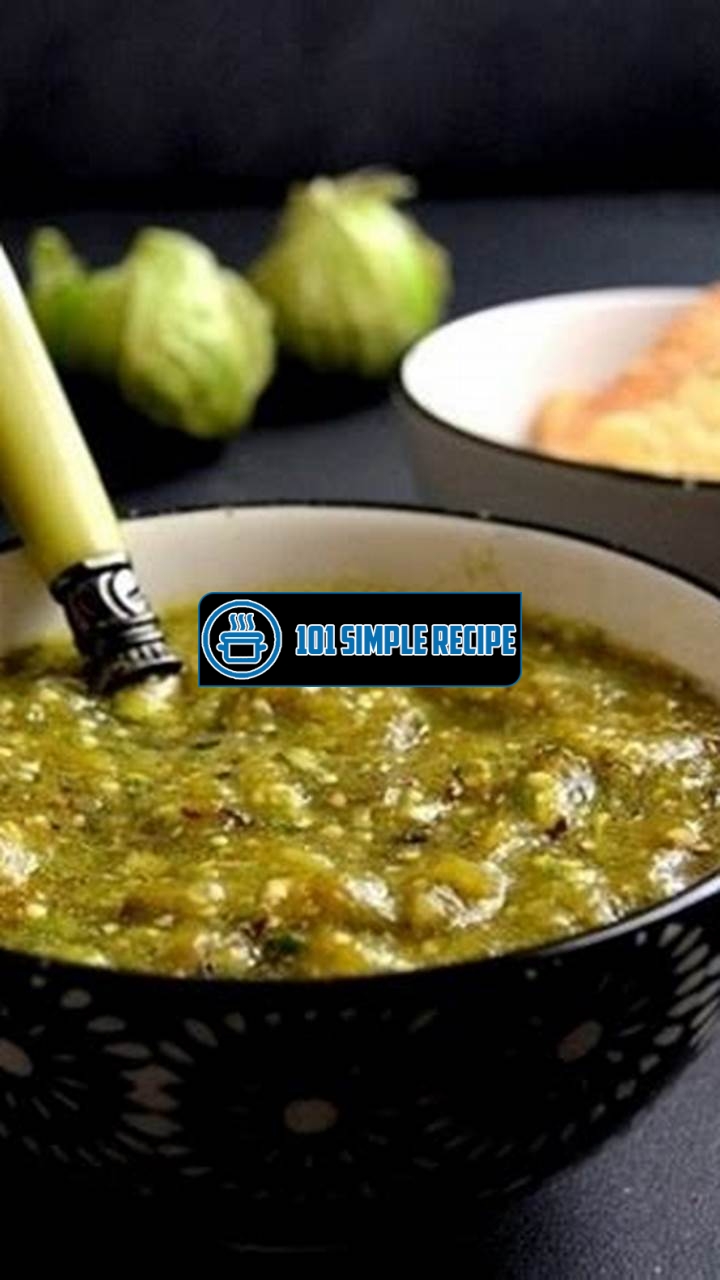Are you ready to take your salsa game to the next level? Look no further! Master the art of making spicy salsa verde and add a punch of flavor to your meals. ️ This zesty Mexican sauce is incredibly versatile and can be used as a dip, marinade, or condiment. Whether you’re a spice enthusiast or just looking to add some excitement to your dishes, this is the perfect recipe for you. In this article, we’ll guide you through the steps of creating a delicious salsa verde that will leave your taste buds tingling. So grab your ingredients and let’s get started!

Introduction to Salsa Verde
Discover the origins and significance of salsa verde, a tangy and spicy sauce that adds a burst of flavor to your meals.
What is Salsa Verde?
Salsa verde, which translates to “green sauce” in Spanish, is a versatile condiment that originated in Mexico. It is typically made with a combination of fresh green herbs, such as cilantro and parsley, jalapeños or other chili peppers, garlic, onions, and tangy citrus juice. The vibrant green color of the sauce comes from the abundance of herbs and vegetables used in its preparation.
Salsa verde can be classified into two types: cooked and raw. Cooked salsa verde involves simmering the ingredients together to blend the flavors, while raw salsa verde is made by simply blending the ingredients until smooth. Both variations offer distinct tastes and are used in different culinary applications.
This zesty sauce can be mild or spicy, depending on the amount of chili peppers used. It is incredibly versatile and can be used as a dipping sauce, marinade, or topping for various dishes, including tacos, burritos, grilled meats, seafood, and even eggs. The tangy and refreshing flavor of salsa verde adds a delightful kick to any meal.
Traditional Uses of Salsa Verde
Salsa verde has a rich history and has been a staple in Mexican cuisine for centuries. It is a traditional accompaniment to many classic dishes, such as enchiladas, chiles rellenos, and tamales. In Mexican culture, salsa verde is revered for its ability to enhance the flavors of a wide range of dishes.
Additionally, salsa verde is often used as a dipping sauce for tortilla chips or as a topping for grilled vegetables, quesadillas, and grilled fish. Its tangy and vibrant flavor profile adds a refreshing element to any dish, making it a favorite condiment for those seeking a burst of flavor.
Furthermore, salsa verde can be used as a marinade for meats, especially chicken and pork. The acidity from the citrus juice helps tenderize the meat while infusing it with the bold flavors of the herbs and peppers. The result is a succulent and flavorful dish that is hard to resist.
Overall, salsa verde is a versatile and essential component of Mexican cuisine. Its tangy, spicy, and herbaceous flavors make it the perfect complement to a variety of dishes.
Why Make Spicy Salsa Verde?
If you are someone who enjoys the thrill of spice, making spicy salsa verde is a great way to elevate your meals. Adding the heat of jalapeños or other chili peppers to the traditional salsa verde recipe can take the flavor profile to a whole new level.
The spiciness in salsa verde comes from the chili peppers, which contain capsaicin, the compound responsible for the fiery sensation. Capsaicin not only adds heat but also releases endorphins in your brain, giving you an exhilarating feeling of satisfaction.
By making your own spicy salsa verde, you have full control over the level of heat. You can experiment with different types of chili peppers and adjust the quantities according to your preference. Whether you enjoy a mild kick or crave the intense heat of a habanero, spicy salsa verde allows you to tailor the sauce to your taste buds.
Spicy salsa verde can be used in the same ways as the traditional version. It adds a fiery element to tacos, burritos, grilled meats, and seafood, creating a flavor explosion that leaves you wanting more. The combination of the tangy, spicy, and herbaceous flavors in spicy salsa verde creates a symphony of tastes that will take your dishes to new heights.
In conclusion, mastering the art of making spicy salsa verde not only adds an exciting and bold flavor to your meals, but it also allows you to personalize the level of heat according to your taste preferences. So why not embark on this culinary adventure and add some spice to your life with homemade spicy salsa verde?
Choosing the Right Ingredients
In order to master the art of making spicy salsa verde, it is essential to choose the right ingredients. By selecting the perfect combination of flavors, you can create a delicious salsa that will tantalize your taste buds and leave you wanting more.
Tomatillos: The Star Ingredient
When it comes to making salsa verde, tomatillos are the star ingredient. These small, green fruits are similar in appearance to tomatoes but have a unique tangy flavor. They are the backbone of any authentic salsa verde recipe and provide the perfect base for the dish.
Tomatillos are known for their bright green color and papery husk. When selecting tomatillos, be sure to choose ones that are firm and have a vibrant green color. Avoid any tomatillos that are mushy or have a yellowish hue, as this indicates that they are overripe or past their prime.
Pro Tip: For a spicier salsa, you can choose tomatillos that have a yellow or purple tint. These varieties tend to have a higher heat level and will add an extra kick to your salsa verde.
The Perfect Peppers
Another key ingredient in spicy salsa verde is peppers. Whether you prefer a mild or fiery salsa, there are a variety of peppers you can choose from to achieve your desired level of heat.
Jalapeños are a common choice for salsa verde and offer a moderate level of spice. They have a slightly fruity flavor that pairs well with the tangy tomatillos. If you prefer a milder salsa, you can remove the seeds and ribs from the jalapeños before adding them to the recipe.
For those who enjoy a spicier kick, serrano peppers are an excellent option. They are smaller and hotter than jalapeños, adding a fiery punch to your salsa. Remember to handle these peppers with caution and avoid touching your face or eyes after handling them, as they can cause irritation.
Spice Alert: If you really want to turn up the heat, you can experiment with other types of peppers, such as habaneros or ghost peppers. Just keep in mind that these peppers are extremely hot, so use them sparingly – unless you are a true heat-seeker!
Additional Flavor Enhancers
In addition to tomatillos and peppers, there are several other flavor enhancers you can add to your spicy salsa verde. These ingredients will take your salsa to the next level and add depth to the overall flavor profile.
Cilantro is a classic herb that is often used in salsa verde. Its fresh and bright flavor complements the tangy tomatillos and adds a refreshing element to the salsa. Be sure to chop the cilantro finely before adding it to the mix.
Garlic and onions are also essential components of salsa verde. They provide a savory and aromatic base that enhances the overall flavor of the salsa. To add a hint of sweetness, you can also include a squeeze of lime juice or a sprinkle of sugar.
Flavor Fusion: For an added burst of flavor, you can experiment with other ingredients like avocado, mango, or even pineapple. These additions will bring a unique twist to your salsa verde and surprise your taste buds.
By carefully selecting the right ingredients for your spicy salsa verde, you can create a mouthwatering salsa that will impress your family and friends. So go ahead, unleash your creativity in the kitchen, and enjoy the incredible flavors of homemade salsa verde!
If you’re looking for another delicious recipe, check out this White Castle recipe. It’s a unique take on a classic fast food favorite.
Preparation and Cooking Techniques
Master the methods and techniques required to prepare and cook the ingredients for the perfect spicy salsa verde.
Cleaning and Roasting Tomatillos
Cleaning and roasting tomatillos is an essential step in making spicy salsa verde. To start, gently remove the papery husks from the tomatillos and rinse them thoroughly under cold water. This will help get rid of any dirt or debris on the surface. Once cleaned, you can either roast the tomatillos in the oven or on a stovetop.
If you choose to roast them in the oven, preheat it to 400°F (200°C). Arrange the cleaned tomatillos on a baking sheet lined with parchment paper. Place them in the oven and let them roast for about 10-15 minutes until they become soft and slightly charred. Keep an eye on them to ensure they do not burn.
To roast the tomatillos on a stovetop, heat a dry skillet over medium-high heat. Place the cleaned tomatillos directly on the skillet and let them roast for approximately 7-10 minutes, turning them occasionally, until they are soft and charred.
Roasting the tomatillos is important as it helps enhance their flavor and adds a smoky element to the salsa verde. The roasting process also softens the tomatillos, making them easier to blend later on.
Handling and Roasting Peppers
Handling and roasting peppers is another crucial step in creating a delicious spicy salsa verde. There are several types of peppers you can use to give your salsa verde some heat and flavor, such as jalapeños or serranos.
Start by handling the peppers with care, as they can be quite spicy. It is recommended to wear gloves while handling them to protect your hands. Use a sharp knife to remove the stems and slice the peppers in half lengthwise.
To roast the peppers, you can either do it in the oven or on a stovetop. If using the oven, preheat it to 400°F (200°C). Place the pepper halves on a baking sheet lined with parchment paper and roast them for around 10-15 minutes. Keep an eye on them, as you want them to be slightly charred but not burnt.
If roasting on a stovetop, heat a dry skillet over medium-high heat. Place the pepper halves directly on the skillet and let them roast for approximately 7-10 minutes, turning them occasionally, until they are charred on all sides.
Roasting the peppers helps to bring out their natural sweetness and adds a smoky flavor to the salsa verde. It also helps to soften the peppers, making them easier to blend.
Blending and Seasoning
After cleaning and roasting the tomatillos and peppers, it’s time to blend them together to create the perfect spicy salsa verde. Start by transferring the roasted tomatillos and peppers to a blender or food processor.
Add additional ingredients to enhance the flavor of your salsa verde, such as garlic, onion, cilantro, lime juice, and salt. The amount of each ingredient can be adjusted according to your taste preferences. Use a moderate amount of each, ensuring that the flavors are well-balanced.
Blend the ingredients until you achieve a smooth and creamy consistency. If you prefer a chunkier salsa verde, blend it for a shorter period of time. Taste the salsa and add more salt or lime juice if needed.
Once blended to your desired consistency and taste, transfer the salsa verde to a serving bowl or storage container. It is best to let the salsa sit for at least 30 minutes before serving to allow the flavors to meld together.
Now you have mastered the art of making spicy salsa verde! Use it as a delicious condiment for tacos, enchiladas, grilled meats, or simply enjoy it with tortilla chips. Experiment with different variations by adding other ingredients like avocado or pineapple to create your own unique salsa verde recipe.
For those watching their weight, we have a weight loss recipe that you might find helpful. It’s a healthy and tasty option to incorporate into your diet.
Customizing Your Spicy Salsa Verde
Discover how to personalize your spicy salsa verde by experimenting with different ingredients and flavors. Whether you’re a fan of mild flavors or prefer an extra kick of spice, there are several ways to customize your salsa verde to suit your taste preferences. Let’s explore some exciting options!
Adding a Citrus Twist
One way to enhance the flavor of your spicy salsa verde is by adding a citrus twist. The tangy and refreshing taste of citrus fruits can bring a delightful balance to the heat of the salsa. Consider squeezing some fresh lime or lemon juice into your salsa verde to give it a bright and zesty flavor. This addition will complement the spicy elements and add a refreshing twist to your dish.
Incorporating Herbs and Spices
Another way to amp up the flavor profile of your salsa verde is by incorporating herbs and spices. Herbs like cilantro and parsley can add a fresh and earthy taste to your salsa. Chop them finely and mix them into the salsa to infuse it with their aromatic flavors. Additionally, spices such as cumin, oregano, or even a pinch of cinnamon can add depth and complexity to your salsa verde. Experiment with different combinations of herbs and spices to create a unique flavor that suits your palate.
Creating Mild or Extra Spicy Variations
The level of spiciness in your salsa verde is entirely up to you. If you prefer a milder version, start by using milder chili peppers such as poblanos or Anaheim. These peppers have a gentle heat and can still provide a nice kick without overwhelming your taste buds. On the other hand, if you can handle the heat, consider using hotter chili peppers like jalapeños or serranos to give your salsa verde an extra spicy punch. Remember to remove the seeds and membranes from the peppers if you want to reduce the heat level.
️ Additionally, you can vary the spiciness of your salsa by adjusting the number of chili peppers you use. For a mild version, use just a few peppers, and for a spicier version, increase the quantity. You can also play around with other ingredients such as hot sauce or crushed red pepper flakes to intensify the heat. The key is to taste and adjust as you go, adding more spice gradually until you achieve the desired level of heat.
By customizing your spicy salsa verde, you can create a flavor profile that satisfies your taste buds. Whether you prefer a tangy citrus twist, an aromatic blend of herbs and spices, or a mild or extra spicy variation, the possibilities are endless. So grab your ingredients, put on your chef hat, and get ready to master the art of making a scrumptious spicy salsa verde!
If you’re hosting a party and need a refreshing beverage, try our punch bowl recipe. It’s a crowd-pleaser and perfect for any occasion.
Serving and Storing Spicy Salsa Verde
When it comes to mastering the art of making spicy salsa verde, serving and storing techniques are key to ensuring maximum flavor and longevity. Whether you’re preparing this delicious condiment for a special occasion or simply for everyday meals, knowing the best ways to serve and store your spicy salsa verde will elevate your culinary skills. Here are some tips to help you make the most of your homemade salsa verde:
Pairing with Dishes
Salsa verde is a versatile sauce that pairs well with a variety of dishes. Its tangy and spicy flavor can enhance the taste of numerous meals, making it a must-have condiment in your kitchen. Here are some ideas on how to best pair salsa verde with different dishes:
- Tacos: Spread a generous amount of salsa verde over your favorite tacos for an extra kick of flavor.
- Enchiladas: Drizzle salsa verde over your enchiladas, whether they’re filled with chicken, cheese, or vegetables, for a burst of freshness.
- Grilled Meats: Use salsa verde as a marinade or sauce for grilled meats such as chicken, beef, or fish. The zesty flavors will complement the smokiness of the meat.
- Vegetables: Toss cooked vegetables like roasted cauliflower, zucchini, or bell peppers in salsa verde to add a tangy and spicy twist.
- Quesadillas: Serve salsa verde as a dipping sauce alongside cheese-filled quesadillas for a delightful combination.
Proper Storage Techniques
To ensure the longevity and freshness of your homemade salsa verde, proper storage techniques are crucial. Follow these tips to keep your salsa verde tasting its best:
- Airtight Container: Transfer the salsa verde into an airtight container to prevent air from oxidizing the sauce and diminishing its flavor.
- Refrigeration: Store the salsa verde in the refrigerator at a temperature below 40°F (4°C). This will help maintain its freshness for up to one week.
- Labeling and Date: Remember to label the container with the date of preparation to keep track of its shelf life.
- Freezing: If you want to extend the shelf life further, consider freezing your salsa verde in small portions. It can be kept in the freezer for up to three months.
Utilizing Leftover Spicy Salsa Verde
Don’t let any leftover salsa verde go to waste! Here are a few creative ways to utilize your extra spicy salsa verde:
- Marinade: Use leftover salsa verde as a marinade for chicken, pork, or tofu for an extra punch of flavor in your next meal.
- Dressing: Mix salsa verde with olive oil and vinegar to create a tangy dressing for salads or grain bowls.
- Sandwich Spread: Jazz up your sandwiches by spreading salsa verde instead of traditional condiments like mayonnaise or mustard.
- Stuffed Peppers: Fill bell peppers with a mixture of salsa verde, cooked rice, and cheese, then bake to perfection for a tasty side dish or appetizer.
- Flavor Enhancer: Add a spoonful of salsa verde to soups, stews, or sauces to elevate their flavor profile.
By following these tips, you’ll be able to serve and store your spicy salsa verde with confidence, ensuring it remains flavorful and fresh for longer periods. Get creative with pairing and utilizing leftovers to truly master the art of making this delicious condiment.
Frequently Asked Questions
Thank you for reading our article about the spicy salsa verde recipe! Here are some common questions that readers have asked:
| No. | Questions | Answers |
|---|---|---|
| 1. | How spicy is this salsa verde? | This salsa verde has a nice kick of heat, but it’s not overly spicy. You can adjust the spiciness by adding more or fewer jalapenos. |
| 2. | How long does this salsa verde last? | This salsa verde can be stored in an airtight container in the refrigerator for up to one week. |
| 3. | Can I freeze this salsa verde? | Yes, you can freeze this salsa verde in a freezer-safe container for up to three months. Just thaw it in the refrigerator before using. |
| 4. | What can I serve with this salsa verde? | This salsa verde goes well with tortilla chips, tacos, grilled meats, and even roasted vegetables. |
| 5. | Can I substitute the tomatillos? | If you can’t find tomatillos, you can use green tomatoes as a substitute. However, the flavor will be slightly different. |
| 6. | Is this salsa verde gluten-free? | Yes, this salsa verde recipe is gluten-free, as it only uses fresh ingredients without any gluten-containing additives. |
Thank You for Reading!
We hope you enjoyed learning how to make our delicious spicy salsa verde. Don’t forget to bookmark our page for future reference! If you have any more questions or feedback, please feel free to reach out. Happy cooking!
Jump to Recipe
Spicy Salsa Verde Recipe

Learn how to make a flavorful and spicy salsa verde with this easy recipe. Perfect for dipping or adding to your favorite Mexican dishes.
- 1 pound tomatillos
- 2-3 jalapeno peppers
- 1 small onion
- 2 cloves garlic
- 1/2 cup cilantro leaves
- 1 tablespoon lime juice
- 1 teaspoon salt
- 1/4 teaspoon cumin
- Remove the husks from the tomatillos and rinse them. Cut the tomatillos into quarters. Remove the seeds from the jalapeno peppers and dice them. Finely chop the onion, garlic, and cilantro leaves.
- In a blender or food processor, combine the tomatillos, jalapeno peppers, onion, garlic, cilantro leaves, lime juice, salt, and cumin. Blend until smooth.
- Taste the salsa and adjust the spiciness by adding more jalapeno peppers if desired.
- Transfer the salsa to a bowl and refrigerate for at least 1 hour to allow the flavors to meld. Serve chilled with tortilla chips or use as a topping for your favorite Mexican dishes.






